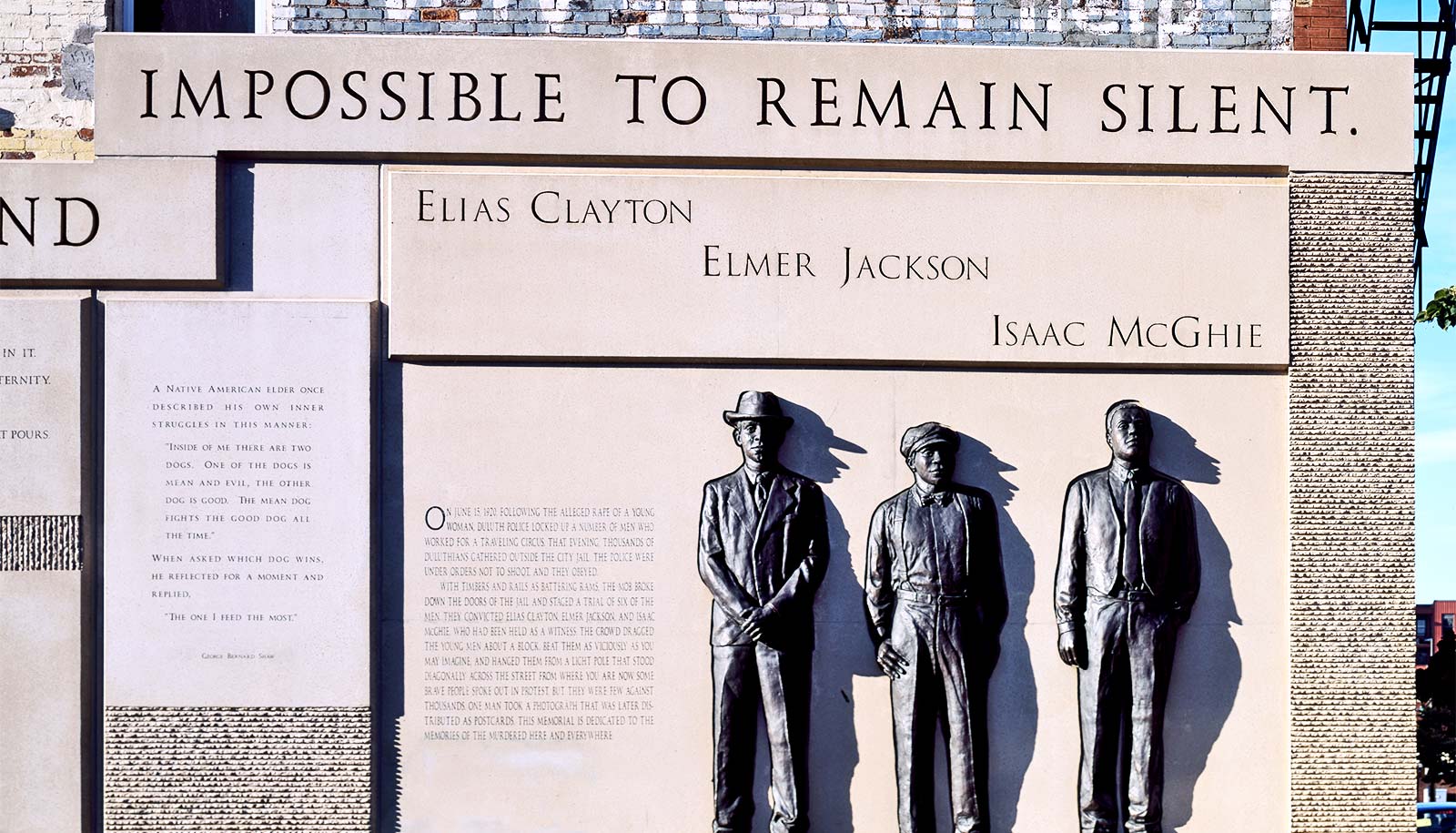A new book about a shocking 1928 incident in upstate New York traces a current of anti-Semitism in American politics.
Barbara Griffiths was four years old when, on September 22, 1928, she wandered into the woods surrounding the village of Massena, in upstate New York, and disappeared. Hundreds of locals, organized by Massena’s police and firefighters, searched frantically through the night and into the next day.
But it was within only a few hours of Barbara’s vanishing that a rumor began to spread across Massena: Jews had kidnapped and killed the girl in a ritual murder. The theory quickly caught fire, finding believers not just in the townsfolk, but also in powerful figures such as state police officers and Massena’s mayor. Barbara ultimately turned up a day after she’d gone missing—having innocently gotten lost in the dense woods—but the accusation persisted in local and national papers for weeks.
The blood libel, the idea that Jews use the blood of Christian children for rituals, has a long, dark history in Central and Eastern Europe, dating back to the Middle Ages. The incident in Massena was the first—and, to this day, the only—known instance of blood libel in the United States, and took place during a time of mass immigration of Jews and Catholics to the country. The fraught political climate may have fueled the escalation of anti-Semitism.
Nearly a century later, anti-Semitism persists in America, even on the streets where Jews have historically felt most accepted. New York City crime statistics indicate a spike in reported anti-Semitic hate crimes this year, with 110 in the first quarter of 2019, compared to 58 in the first quarter of 2018. The most recent FBI data showed a 37% national rise in hate crimes against Jews from 2016 to 2017, and noted an increase in overall hate-related incidents for three consecutive years.
And while the Massena blood libel is unique in American history, studying it in context can help shed light on how anti-Semitism and other forms of prejudice operate today. The new book by New York University history professor Edward Berenson, The Accusation: Blood Libel in an American Town (W. W. Norton & Co., 2019), explores the events in Massena and the history of blood libel around the world. NYU News spoke with Berenson about the socio-political forces that allowed the blood libel to take root in Massena, his personal connection to the story, and how anti-Semitism reveals itself in our modern society:
What was the cultural backdrop for the blood libel in Massena?
I would start with mass immigration, which by the 1920s was three and a half decades old. Before that mass immigration, the United States was overwhelmingly a Protestant country; after the 1880s, you had a huge influx of Catholics and Jews, and it really changed the country a lot.
So in the 1920s—and this will have echoes for the present—there were an awful lot of people who were not so happy about this new demographic situation, and one of the main organizations that opposed it was a revived Ku Klux Klan. There’s some evidence that there were several members of the volunteer fire company in Massena who were members of the Klan. And there were essentially no African Americans who lived up there, so most of the Klan’s hostility was directed against Catholics and Jews, and people who were seen to be connected to immigration in one way or the other.
Another key element of the context was the activities of Henry Ford, the automaker. He bought a newspaper in 1919 called The Dearborn Independent, and he ran very violently anti-Semitic editorials every week and then collected them into a book called The International Jew. It was all about how Jews were supposedly taking over the world, how they had too much power, and that real, 100% Protestant Americans should be vigilant about all this. His newspaper had a very high circulation. In the middle of the 1920s, The Dearborn Independent had a higher circulation than the New York Times.
And this resonated all too well with the politics of the time.
Yes. In 1928, the year when the Massena blood libel took place, you had a very, very contentious presidential election between two guys who seemed to really represent opposite understandings of what America was all about.
Republican candidate Herbert Hoover was Protestant, from the Midwest, and so he represented to his supporters this kind of traditional understanding of who Americans were. They were white Protestants from England and northern Europe. And Democratic candidate Al Smith, whose family was part Irish and part Italian, represented the urban immigrants.
Religious venom surrounded this campaign. There was horrible hostility to Catholics because Al Smith was the first Catholic candidate ever for the presidency. And some of Al Smith’s top advisors were Jews, and everybody knew that they were Jewish. So this election kind of brought together all of these themes that were percolating in the 1920s.
Who was the first to accuse the Jews of ritual murder in Massena?
Massena was an industrial town. There was a huge Alcoa aluminum plant that attracted immigrant workers from the parts of Europe and the parts of Canada where anti-Semitism had raged in the late 19th and early 20th century, and where the blood libel narrative was commonly accepted. And so it’s likely that this immigrant group injected this particular form of anti-Semitism—that is, the accusation that Jews murdered children for their religious rituals. It’s likely that that idea came from one or more of the immigrants who were working in Massena.

What does this blood libel, and its persistent national coverage, reveal about the perception of Jews in America at the time?
In the first place, of course, it revealed that it was possible for Americans to think that Jews could kidnap and murder a young child, and drain his or her blood.
But the optimistic side of all this is that when a little girl came back alive and it was clear that nothing had happened, the overwhelming majority of Americans sided with the Jews against their accusers. In being proven completely, patently false, the accusation aroused a lot of sympathy for American Jews. This shows that the United States was—and is still, I think—a safer place for Jews than most other places in the world.
Why do you think there’s been a recent increase in reported anti-Semitic violence in the United States?
In Europe, in the 19th and 20th centuries, there were explicitly anti-Semitic newspapers, and explicitly anti-Semitic political parties with the project to diminish the so-called power of Jews, or even to kick them out of whatever country they were in.
In the United States, there’s no tradition of media dedicated to hostility to Jews, with the exception of Henry Ford’s anti-Semitic newspaper. But now, with the internet, we do have means of communication and circulation that can spread and foster and magnify the kinds of ideas that can lead to violence. And so because of that, I think we may need to be more vigilant.
Could a blood libel accusation happen again here?
What the existence of that blood libel in 1928 reveals is that there was, and maybe still is, an undercurrent of extreme hostility to Jews, and the willingness to believe that Jews are incredibly evil. Even though I doubt that we’re going to see a lot of blood libels, we do have to think about the possibility that the notion that Jews are evil is out there, and could easily be revived in a context of populism everywhere.
Populism sees elites as being the source of all of our problems, and Jews have pretty commonly been seen as part of this elite—a banking elite, a business elite, and, nowadays, a global elite. And so it’s possible that the attack on global elites could evolve into a more specific attack on the Jewish part of that elite, especially given that the Massena blood libel shows us that there is precedent for the belief that Jews are capable of doing the worst imaginable things.
You bring your family’s history into the book: your great-grandparents, Jewish immigrants to the US from Eastern Europe, settled in Massena. And then both you and your father were born there as well. What do you hope the reader gets from the personal context?
I hope readers will get more of a sense of immediacy. When you talk about things that happened a long time ago, it seems so distant—like it doesn’t really have anything to do with us. When the historian is connected directly through his or her family to the events in question, I think that may give readers a sense that history is more alive than they might otherwise have thought. That the past isn’t really past. It’s still with us, and it resides in people’s memory.
Source: NYU


